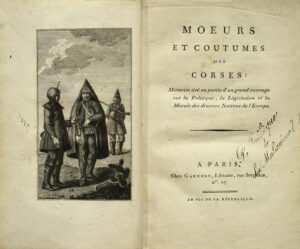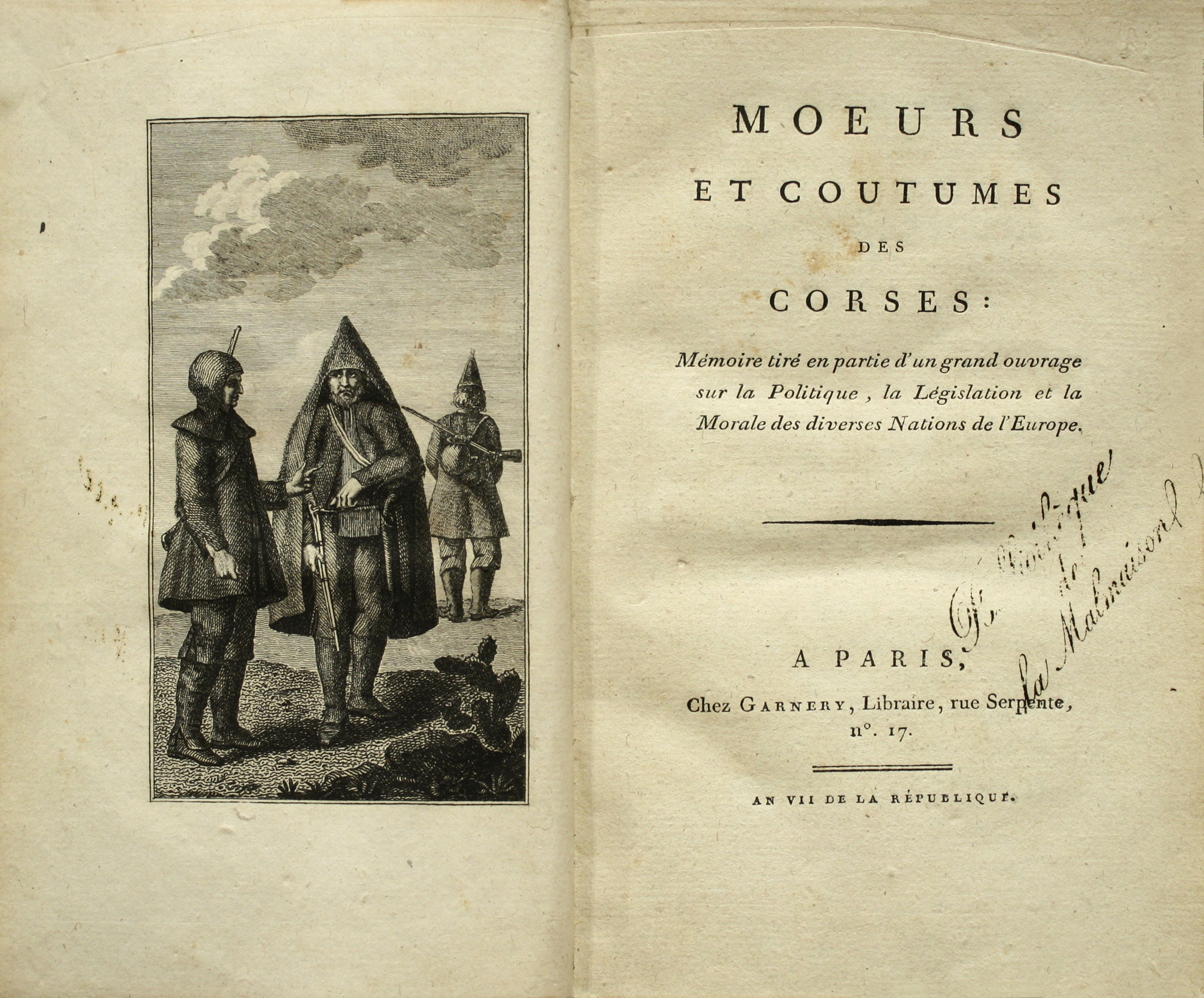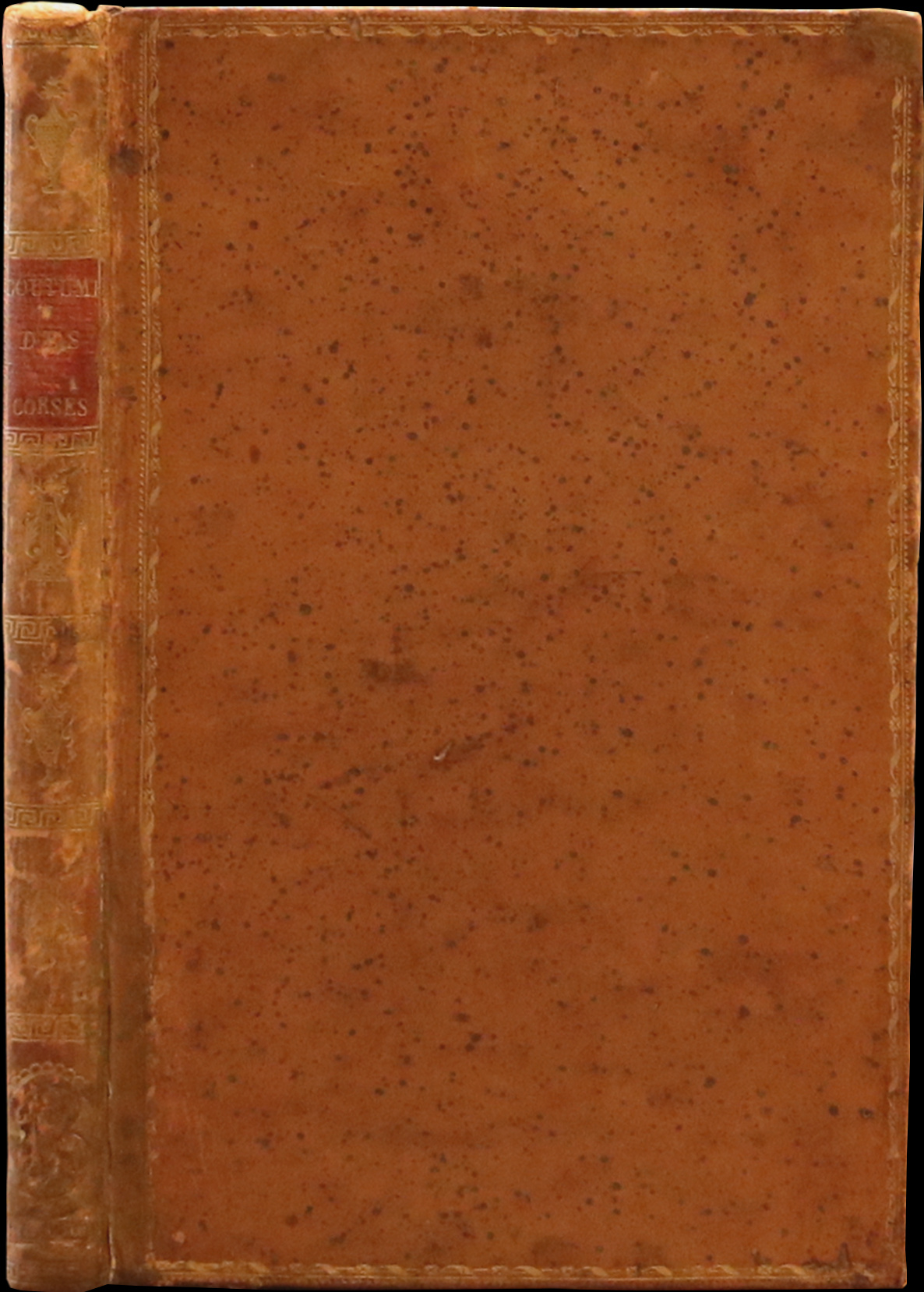Paris, Garnery, An VII (1798-99).
Large 8vo [198 x 122 mm] of (4) ll., 1 frontispiece, 112 pp. Bound in full light-brown roan, gilt border on the covers, flat spine decorated with gilt fleurons, gilt PB cipher stamped at the foot of the spine, red morocco lettering piece, gilt over marbled edges. Slightly rubbed spine. Contemporary binding.
First edition of this interesting trêtise about the Corsicans in France.
Barbier, III, 323; Monglond IV, 795; Martin-W. 13429; INED 1841; Lipperheide JbÇ; Brunet, VI, 25883.
"Economic and social geography. Resources and customs of this island, that the monarchy severely neglected and that the Republic needs to bring out. It also needs to fight against anarchy and the plague” (INED).
Gabriel Victor Feydel (1756- April 22nd, 1840) is a French journalist. Born in 1756, he received a military and technical education. He claims to have been a lieutenant in his youth, but he is only known as a writer and a journalist. He publishes his first work L'art de nager, under the pseudonym of Nicolas Roger, in 1783, pseudonym that he will use several times. In 1787 and 1788 he is in charge of the daily letters to the editor in a series of letters where philological erudition, polemic and Voltairian irony are mixed.
In 1789, as secretary of the "Société des Amis de la Constitution" Gabriel Feydel writes with Choderlos de Laclos L'Observateur, which was one of the very first papers published, during the Revolution. It is according to this function that he cosigns the Discours sur la liberté du théâtre pronounced by La Harpe on December 17th, 1790. The publication of this paper was definitely stopped on October 12th, 1790.
In his Observateur Gabriel Feydel spêks highly of Jacques René’s brochure entitled La Lanterne magique. In 1794, proscribed, he lêves Paris and survives as a hawker.
He rêppêrs under the Directory, enrolled in the expedition to Constantinople by the minister of the foreign relations Aubert. The ship, in which Feydel is, is captured by the English. Held in Corsica, he would only return in Paris in pluviôse an VI (5th month of the French Revolutionary calendar, 1797-98). Gabriel Feydel is the author of the paper Le Régulateur, ou Gazette de Paris et de l'Europe. After an VIII (1799-1800), Gabriel Feydel stops spêking about politics and fills in again the columns of the Journal de Paris with his literary and erudite polemics, exactly like before the Revolution.
In 1799, Feydel addresses to the members of the Directory a report about Corsica, which will be published after under the title Mœurs et coutumes des Corses, in which he points out that “the Corsican is sharp, intrepid, spiritual and dexterous, but excessively lazy of body and mind”. The conclusion of this report is merciless for the behavior of the island’s inhabitants, who, according to him is dangerously contagious: “Marrying French boys with Corsican girls, protecting the agriculture and crêting factories, such were the main mêns used by the government of Versailles to rêch the grêt commercial goal they had in mind, when the island was taken. The experience proved them that the French who settles in Corsica develops the usual laziness of the country, instêd of giving there the example of the French activity”.
The work is illustrated with an engraved frontispiece picturing three Corsicans in traditional costumes.
Remarkable copy from the Malmaison Libraby.
A first mark that enriches this copy is the monogram PB (Pagerie, Bonaparte) in gilt lette rat the foot of the spine, the cipher of Joséphine de Tascher de La Pagerie and of Napoléon Bonaparte.
A second later mark is the stamp "Bibliothèque de la Malmaison" that was put on the title pages for the sales from May to July 1829. There was a brief catalog for these sales: "Notice des livres composant la bibliothèque de La Malmaison, provenant de la succession de S. A. R. le prince Eugène et qui avait appartenu à Napoléon et à l'impératrice Joséphine,... vente au châtêu de La Malmaison les dimanche 28 et lundi 29 juin 1829, les dimanche 5 juillet et lundi 6, les dimanche 12 et lundi 13…"
“At the châtêu de Malmaison, Joséphine had installed a library by the architect Percier, mostly composed of military works”
Olivier assesses that “books with the arms or the cipher of the empress Joséphine are extremely rare”. (OHR, Pl. 2653)
Precious copy with a particularly prestigious and saucy provenance when we know that the imperial couple desired to own this work in which the author gives a calamitous portrayal of Corsica and its population…
Provenance: from the Malmaison Library with the gilt-stamped cipher at the foot of the spine and stamp on the title.



